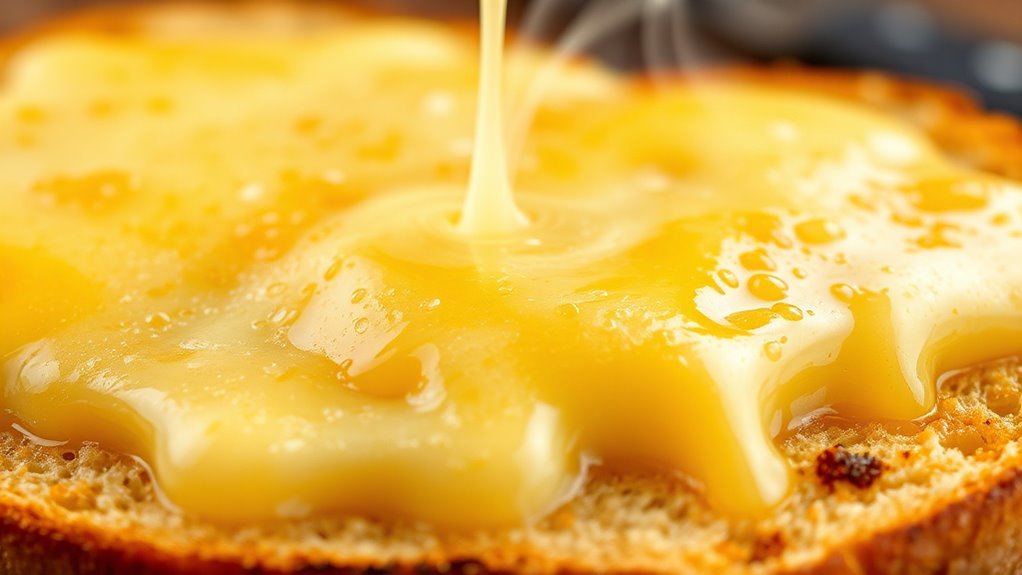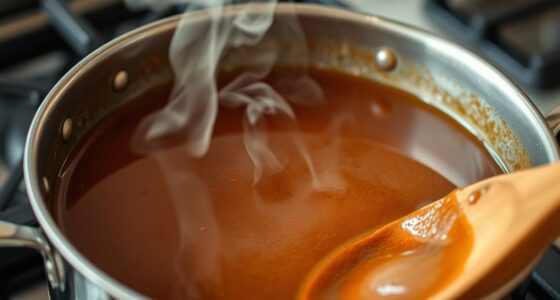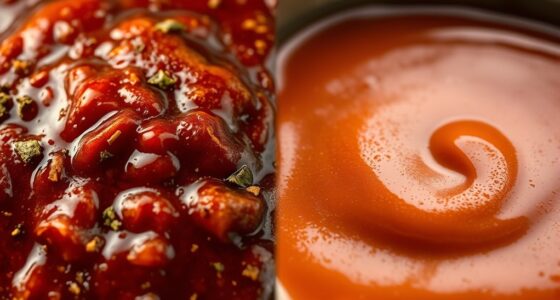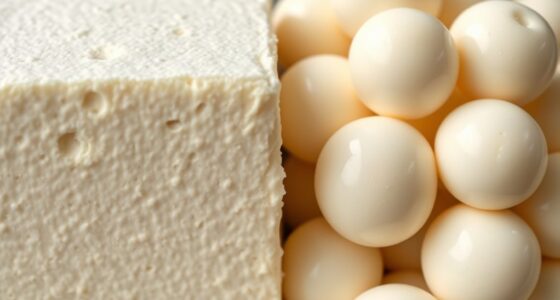To get cheeses that melt smoothly, choose fresh, high-moisture varieties like mozzarella, fontina, or young gouda, and combine them with more aged cheeses like sharp cheddar or Parmesan for added flavor. Finely grate your cheese and melt it slowly over gentle heat while stirring constantly. Avoid low-moisture or aged cheeses if you want a velvety texture. Want tip-to-tail guidance? Keep exploring to master perfect cheese blends every time.
Key Takeaways
- Combine high-moisture cheeses like mozzarella and young gouda for smooth, uniform melts.
- Mix aged cheeses like Parmesan or sharp cheddar with softer cheeses to balance flavor and meltability.
- Finely grate all cheeses to promote even melting and prevent clumping.
- Use gentle, gradual heat and stir constantly to achieve velvety, cohesive cheese blends.
- Incorporate complementary acids (lemon juice or vinegar) to stabilize the melt and enhance texture.
The Science Behind Melting Cheese
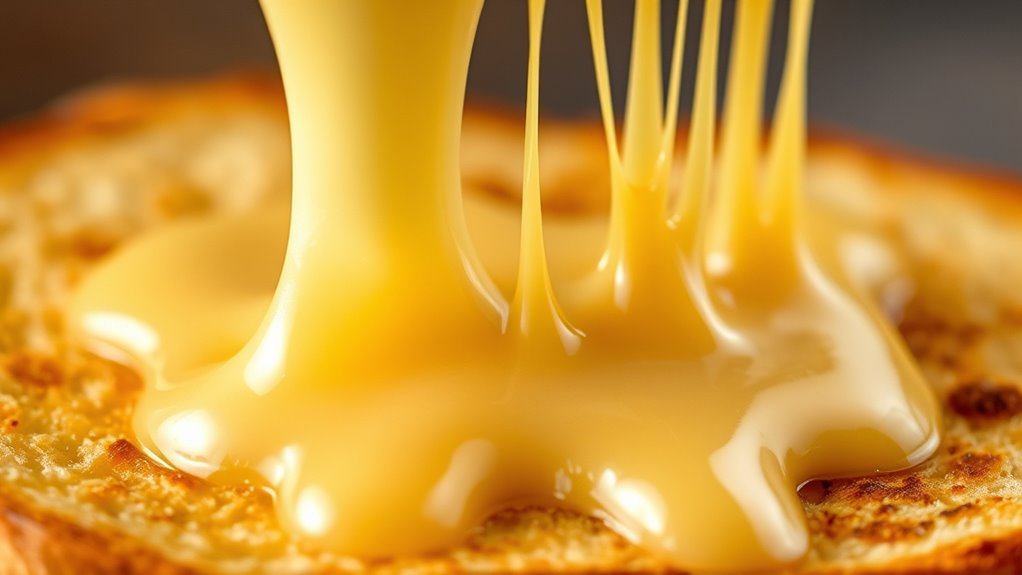
When cheese melts, it’s because heat causes its internal structure to break down, transforming solid into gooey goodness. The process is influenced by cheese aging, which affects moisture and protein levels, and fat content, vital for smooth melting. Younger cheeses typically have higher moisture, making them melt more uniformly, while aged cheeses develop drier textures and complex flavors that can resist melting or cause unevenness. High-fat cheeses, like Brie or cheddar, melt more easily because fat helps create a creamy, smooth consistency. Conversely, low-fat varieties tend to become stringy or rubbery. Understanding these factors helps you predict how a cheese will melt and choose the right type for your dish, ensuring the perfect gooey finish every time. Additionally, the protein structure of cheese plays a crucial role in its melting behavior, influencing how smoothly it transitions from solid to liquid.
Best Cheeses for Smooth, Uniform Melts
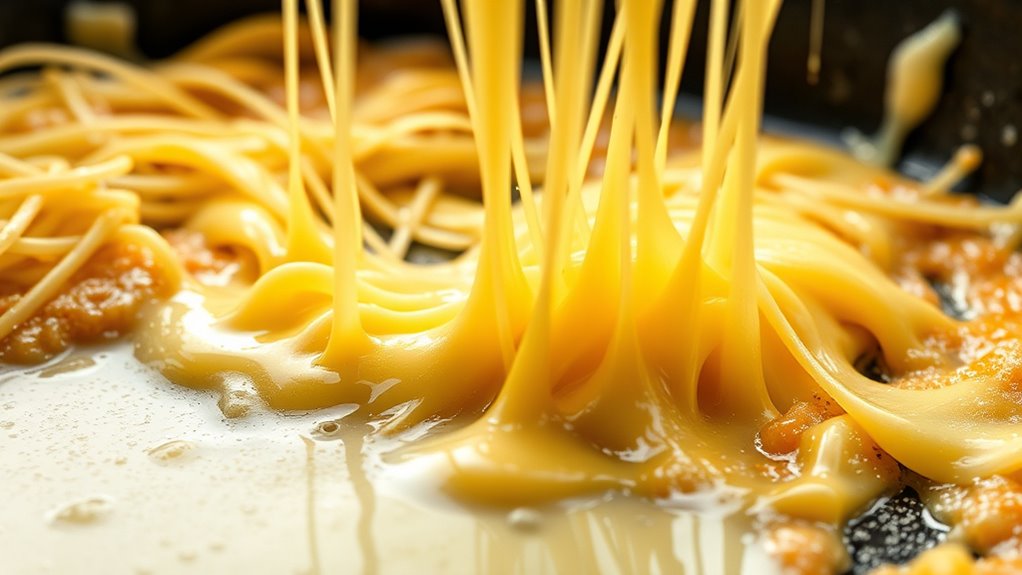
Choosing the right cheese can make all the difference in achieving a smooth, uniform melt. Cheeses suitable for melting often have specific cheese aging processes that influence their texture. Younger cheeses, like young cheddar or mozzarella, tend to melt more evenly because they haven’t fully developed complex proteins that cause separation. Proper cheese storage is also essential; keep cheeses at consistent, cool temperatures to preserve their meltability. Avoid storing cheese too long or in humid environments, which can alter their moisture content and melting qualities. When selecting cheeses, look for ones labeled specifically for melting, such as mozzarella, fontina, or young gouda. These cheeses maintain their smooth, creamy consistency when heated, making them ideal for achieving that perfect melt every time. Additionally, understanding paint preparation and usage guidelines can help ensure your cheese melts evenly without clumping.
Combining Cheeses for Optimal Texture
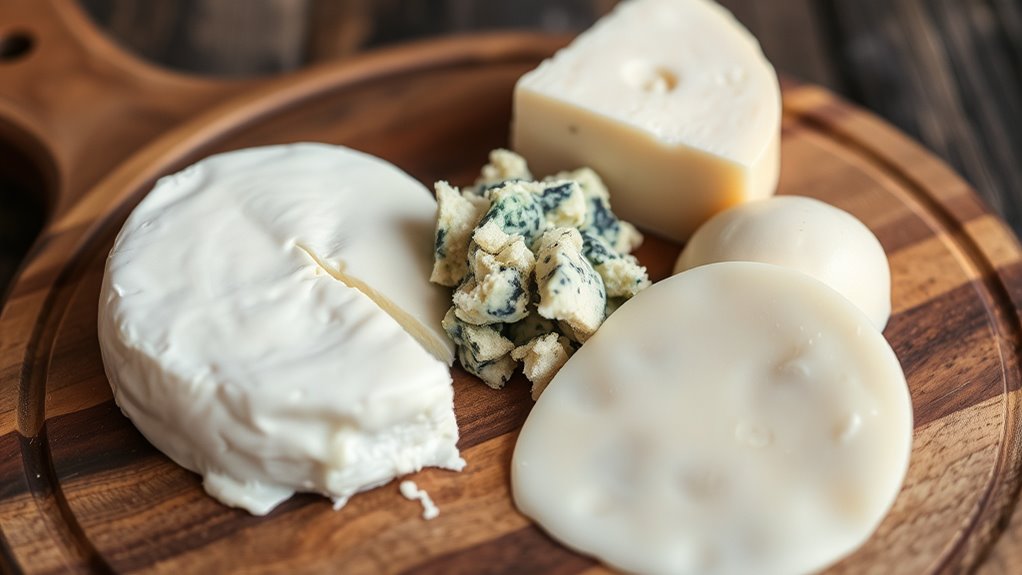
Combining different cheeses can substantially enhance the texture and flavor of your dish, especially when aiming for a smooth, consistent melt. To achieve this, focus on cheese flavor combinations that complement each other, like sharp cheddar with mild mozzarella or creamy gouda. Mixing cheeses with varying moisture levels helps create a balanced, velvety texture. When selecting cheeses, consider cheese packaging tips—buy in blocks rather than pre-shredded, as shredded cheese often contains anti-caking agents that hinder melting. Grate cheeses finely for even melting and better blending. Additionally, understanding cheese moisture content can guide you in choosing the best cheeses for melting. Combining cheeses thoughtfully ensures your dish melts smoothly and boasts a rich, layered flavor profile. Experimenting with different pairings can elevate your culinary creations, making them irresistibly creamy and flavorful every time.
Cheeses to Avoid for Melting Purposes
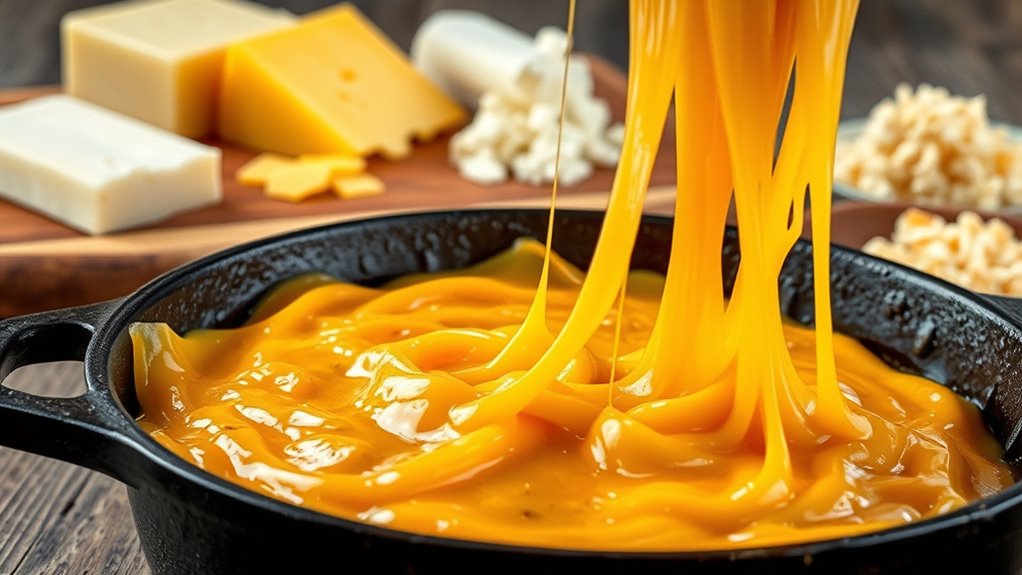
While mixing cheeses can improve meltability and flavor, some varieties simply don’t perform well when heated. Processed cheeses, like American slices or cheese spreads, often melt smoothly but lack complexity and can become rubbery or greasy if overheated. Aged cheeses, such as Parmesan or aged cheddar, tend to resist melting because their moisture content is low, and their proteins are tightly bound. They may soften slightly but won’t achieve the gooey texture you want. Avoid using these cheeses if you’re aiming for a creamy, uniform melt. Instead, opt for fresher, higher-moisture cheeses that melt evenly without becoming stringy or greasy. Knowing which cheeses to sideline helps you craft better, more appealing melts every time. Incorporating cheese moisture content into your selection process can significantly improve your melting results.
Temperature Tricks for Perfect Melts
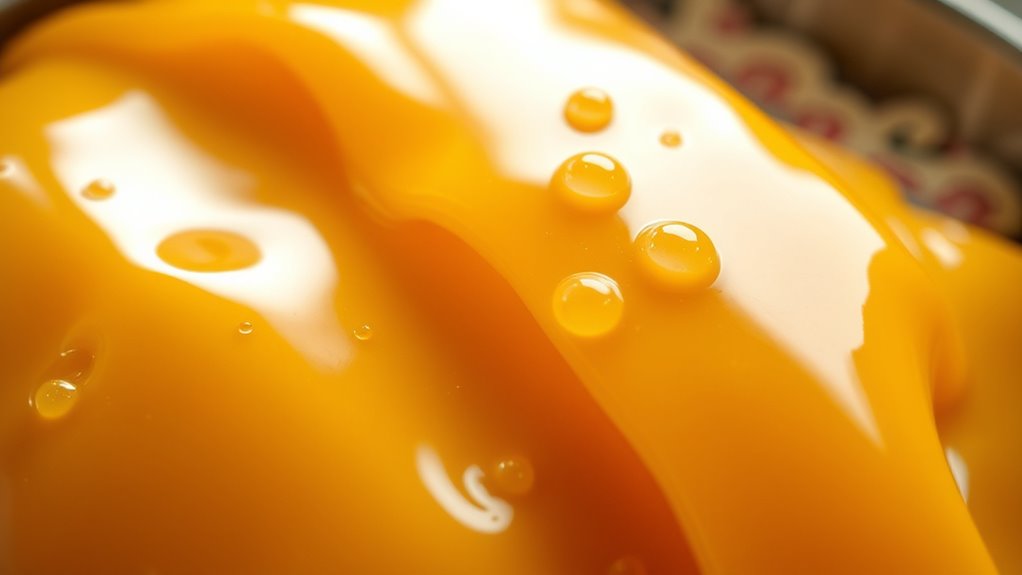
Getting the temperature right is essential for achieving the perfect cheese melt. Too hot, and the cheese can become greasy or stringy; too cold, and it won’t melt evenly. To enhance, consider the cheese’s aging process—aged cheeses tend to melt better at slightly higher temperatures due to lower moisture content. Also, watch the lactose content; cheeses with less lactose melt more smoothly because they’re less prone to becoming grainy.
To get it just right:
- Use low heat to gradually warm the cheese, preventing scorching.
- Stir constantly to distribute heat evenly.
- Adjust temperature based on cheese type, considering aging and lactose levels for optimal melting.
Prepping and Handling Cheese for Better Melting
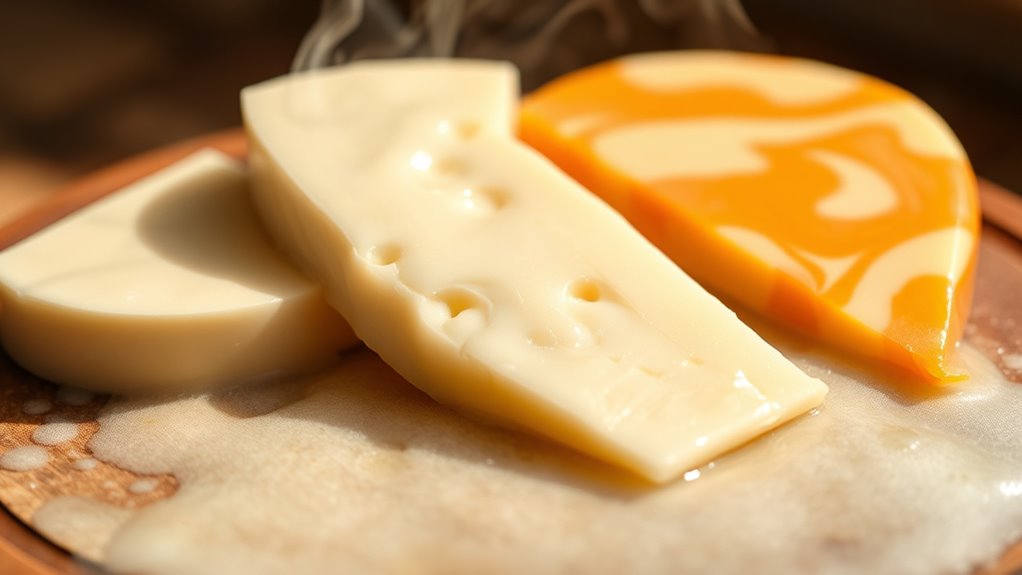
Properly prepping and handling your cheese sets the foundation for a smooth, even melt. Start by storing cheese properly in the fridge, wrapped tightly to prevent moisture loss and flavor changes. When ready to melt, cut cheese into uniform pieces to ensure even heating. Consider flavor pairing: milder cheeses melt better and blend seamlessly, while sharper varieties may need gentle heating to avoid separation. Use a clean, sharp knife to avoid contamination and maintain cheese quality. Always grate or dice cheese before melting for quicker, uniform results. Using the right type of cheese and proper handling can also help prevent clumping or uneven melting, especially if you’re utilizing advanced melting techniques for a perfect finish.
Common Mistakes That Cause Clumping and Separating

One common mistake is overheating your cheese, which can cause it to clump or separate. Using low-quality cheese often leads to poor melting results, making your dish look unappealing. Additionally, neglecting proper stirring techniques can create uneven melting and unwanted textures.
Overheating Cheese Mixtures
Overheating cheese mixtures is a common mistake that can lead to frustrating clumping and separation. When you heat cheese too quickly or at high temperatures, it can disrupt the delicate balance of melting, causing undesirable texture issues. This can interfere with cheese aging processes that develop complex flavor profiles, leading to a less enjoyable dish. To prevent this, keep the heat low and gradually warm your mixture. Additionally, understanding the importance of temperature control can help you achieve perfectly melted cheese every time.
Remember these tips:
- Use gentle, indirect heat to avoid overheating.
- Stir constantly to distribute heat evenly.
- Pay attention to temperature, as even slight overheating can cause separation.
Using Low-Quality Cheeses
Using low-quality cheeses can considerably increase the risk of clumping and separation when melting. Cheeses with poor quality often lack the proper fat and moisture balance needed for smooth melting. Artisanal varieties, on the other hand, undergo careful aging processes that develop complex flavors and improve meltability. Cheeses that aren’t properly aged tend to be drier and more prone to gritty textures or separation. When you choose cheap or mass-produced cheeses, you’re likely sacrificing those essential qualities that help cheese melt evenly. Instead, opt for high-quality, well-aged cheeses, which tend to melt more smoothly and uniformly. Skimping on quality can lead to sticky, stringy, or separated cheese, ruining your dish and wasting ingredients. Additionally, proper aging enhances the cheese’s ability to melt without separating, resulting in a more desirable texture.
Inadequate Stirring Techniques
Inadequate stirring during the melting process can quickly lead to clumping and separation, ruining the texture of your dish. Poor stirring techniques prevent the cheese from melting evenly, causing uneven heat distribution. To avoid this, keep a steady hand and stir constantly, ensuring the heat remains uniform. Incorporating gentle, continuous stirring also helps activate the sound vibrations that can enhance cellular regeneration and overall melting consistency during the process. Here are key tips:
- Use gentle, continuous stirring to promote uniform heat transfer.
- Avoid high heat; instead, melt cheese slowly over low to medium heat.
- Incorporate small amounts of liquid gradually to help distribute heat evenly.
Creative Cheese Blends for Different Dishes
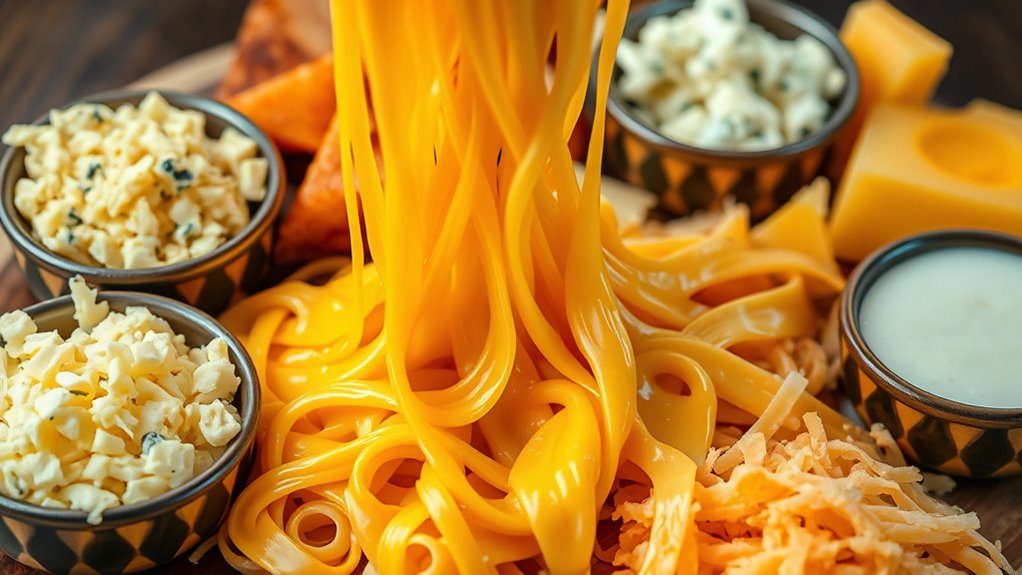
You can enhance your dishes by choosing the right cheese blends. Melty cheese makes pizza irresistibly gooey, sharp blends add flavor to sandwiches, and creamy melts create smooth pasta sauces. Experimenting with these combinations helps you craft delicious, customized meals. Recognizing the culinary versatility of cheese blends allows you to elevate everyday recipes with nuanced flavors and textures.
Melty Cheese for Pizza
Have you ever wondered how to create the perfect melt for your pizza? The key is choosing cheeses that melt smoothly while offering great flavor enhancement. Start with cheeses that have undergone cheese aging, which improves meltability and deepens taste. Combining mozzarella with certain blends ensures a gooey, flavorful finish. To optimize your pizza, consider these tips:
- Use freshly grated cheese for even melting.
- Incorporate mild cheeses like provolone or fontina for creaminess.
- Mix in a touch of aged cheeses like Parmesan for flavor depth without sacrificing melt quality.
These choices help you achieve that ideal, stretchy texture and rich flavor. Selecting the right cheeses and understanding cheese aging allows you to craft a pizza that melts perfectly every time while boosting flavor.
Sharp Blends for Sandwiches
Creative cheese blends with a sharp edge can elevate any sandwich by adding complex flavor and a satisfying bite. Cheddar varieties, especially aged options, bring a bold, tangy kick that complements hearty breads and savory meats. For a well-rounded flavor, pair sharp cheddar with ingredients like caramelized onions, pickles, or mustard. Mixing different cheddar varieties, such as a sharp white cheddar with a crumbly aged cheddar, creates depth and contrast. These flavor pairings make your sandwich more interesting and memorable. Keep in mind that sharp cheeses melt well, ensuring your sandwich remains gooey and satisfying. Experimenting with cheese blends that have a tangy, sharp profile allows you to craft sandwiches with a perfect balance of richness and bite, impressing every time.
Creamy Melts for Pasta
To create irresistibly creamy pasta dishes, selecting the right cheese blends is key. Opt for cheeses with well-developed flavor profiles, which are influenced by cheese aging. Aged cheeses like Parmesan or Gruyère add depth, while softer cheeses like mozzarella or cream cheese provide smoothness. Combining these creates a balanced melt that’s rich and velvety. When choosing cheeses, consider their melting points and flavor complexity to guarantee your pasta remains creamy without becoming greasy. Using a blend allows the flavors to meld beautifully during cooking, delivering a luxurious texture. To maximize flavor, grate cheeses finely and add them gradually. This approach helps you achieve a perfect, creamy consistency that elevates your pasta dish. Remember, the right cheese blend makes all the difference in creating a melt that’s truly indulgent. Attention to detail during the selection process can significantly improve your culinary results.
Expert Tips for Achieving Velvety Cheese Sauces
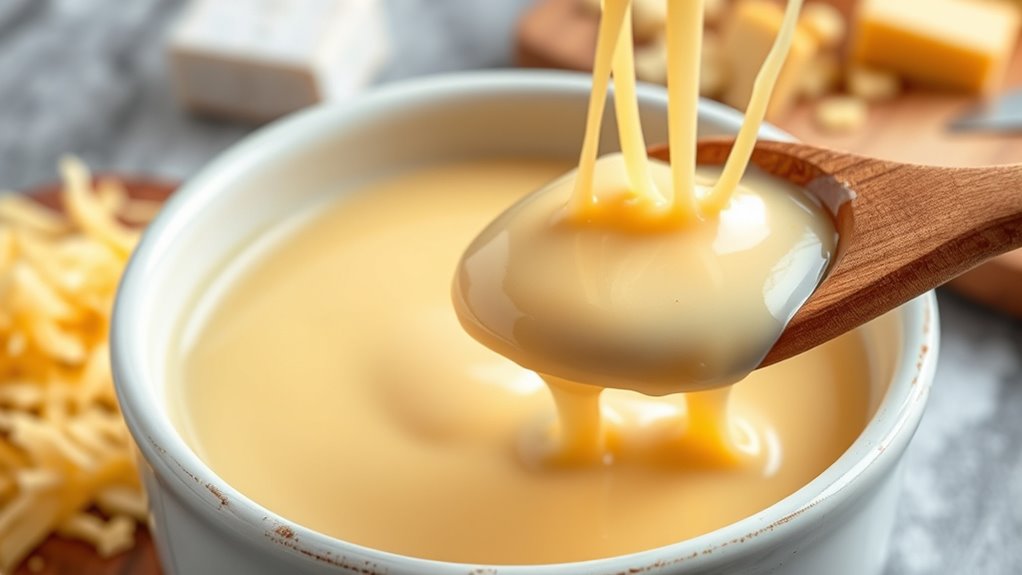
Achieving a velvety cheese sauce hinges on proper technique and ingredient choices. Start by grating your cheese finely; this helps it melt evenly without clumping. Use medium heat and add cheese gradually, stirring constantly to prevent separation. Incorporate a splash of acid, like lemon juice or vinegar, to enhance flavor and stabilize the sauce’s texture. For artisan pairings, consider cheeses like Gruyère or aged cheddar to add depth and complexity. To boost flavor enhancements, add a touch of Dijon mustard or a pinch of nutmeg. Avoid high heat, which can cause the cheese to become grainy. Instead, maintain gentle simmering and patience. With these expert tips, your cheese sauces will turn out irresistibly smooth, rich, and perfect for any dish.
Frequently Asked Questions
Can Processed Cheese Blends Melt Better Than Natural Cheeses?
Processed cheese blends generally melt better than natural cheeses because of their higher melting efficiency, thanks to added emulsifiers. You’ll find they create a smooth, uniform melt ideal for dishes like grilled cheese or nachos. However, be aware that this often comes with a flavor compromise, as processed cheeses tend to have a milder, less complex taste compared to natural cheeses.
How Does Humidity Affect Cheese Melting Quality?
Humidity markedly impacts cheese melting because higher moisture content helps cheese melt more smoothly, giving you that perfect stretch. When storage temperature is too high, cheese absorbs excess humidity, making it more prone to clumping or becoming runny. Conversely, low humidity can dry out cheese, leading to uneven melting. Keep your cheese in a controlled environment to guarantee consistent, silky meltability every time.
Are There Any Cheeses That Melt Quickly but Lack Flavor?
Yes, flavorless cheeses like mozzarella or processed cheese slices often melt quickly but lack depth of flavor. If you’re seeking quick melting options, these cheeses work well, especially in grilled cheese or melted dips. However, they won’t add much taste. To enhance flavor, consider blending them with more flavorful cheeses, but be aware that their quick meltability is mainly due to their moisture content and processing methods.
Does Aging Affect a Cheese’s Melting Properties?
Picture a cheese wheel aging slowly in a cellar, its flavor deepening with each passing year. As cheese ages, its melting consistency often changes—becoming firmer or drier, which can hinder its meltability. The aging process transforms the cheese’s structure, sometimes making it less ideal for melting, especially for dishes requiring smooth, gooey textures. So, yes, aging profoundly affects a cheese’s melting properties, influencing how it behaves when heated.
Can Adding Dairy Additives Improve Melting Consistency?
Adding dairy additives can indeed improve melting consistency. These additives, like emulsifiers and stabilizers, enhance dairy additive benefits by promoting a smoother, more uniform melt. You’ll notice better stretch, creaminess, and reduced separation in your cheese blends. Incorporate these additives carefully, following recommended amounts, to guarantee consistent results. This simple step can elevate your cheese melt quality, making your dishes more appealing and professional-looking.
Conclusion
Now that you know the secrets behind melting cheese, you’re armed to turn any dish into a silky masterpiece. Remember, mastering cheese blends is like riding a bike—you might wobble at first, but with practice, you’ll glide smoothly. So don’t be afraid to experiment and find what works best for you. Soon, your cheese creations will be the talk of the town, melting hearts and mouths alike.
